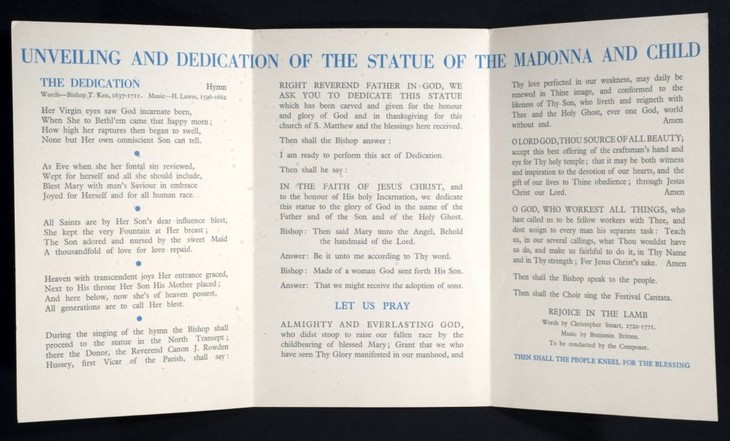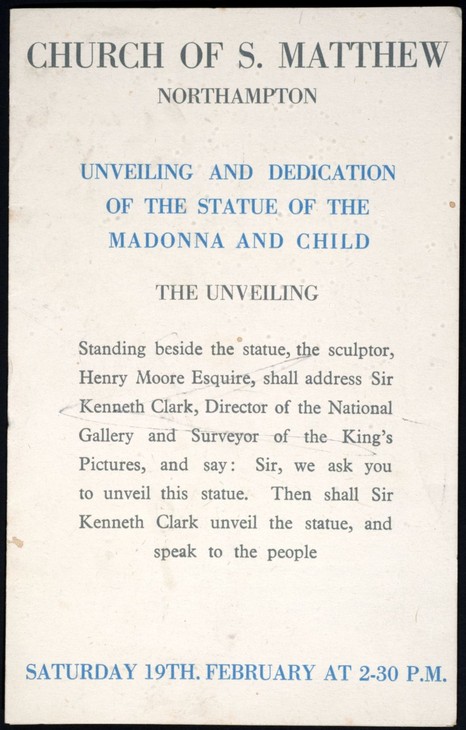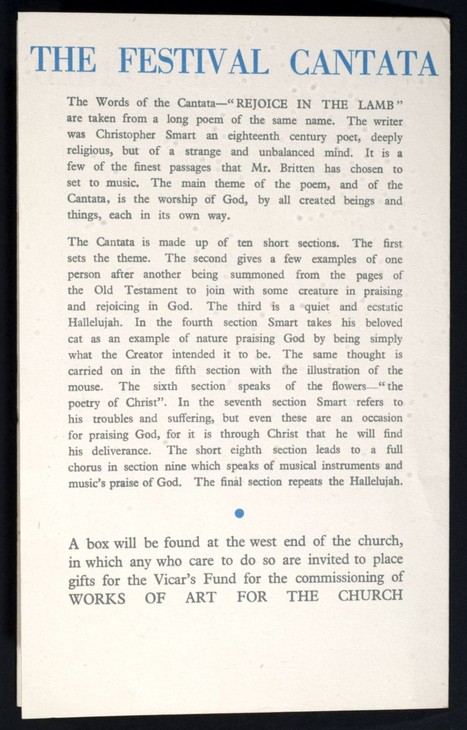Programme for the unveiling and dedication of the statue Madonna and Child, St. Matthew's Church 19 February 1944
In 1942 Reverend Walter Hussey, vicar of St. Matthew’s Church in Northampton, asked Henry Moore whether he would be interested in creating a sculpture of the Madonna and Child for the church. Moore recalled, ‘When I was first asked to carve a Madonna and Child for St Matthew’s, although I was very interested I wasn’t sure whether I could do it, or whether I even wanted to do it’. However, he made a series of small preparatory ideas for the sculpture in clay and subsequently agreed to undertake the commission.
The Northampton Madonna and Child was completed in 1944 and dedicated in the church on 19 February 1944. The service was due to start at 2.30 pm but was delayed by an hour when a German bomb was discovered on the rail line from London, delaying the train bringing Moore and his wife, Sir Kenneth and Lady Clark and the painter Graham Sutherland and his wife. To placate the congregation waiting in the church, the cantata ‘Rejoice in the Lamb’, set to music by Benjamin Britten, was moved to the start of the service. (See Alan Wilkinson (ed.), Henry Moore: Writing and Conversations, Aldershot 2002, p.267.)
Transcript
CHURCH OF S. MATTHEW
NORTHAMPTON.
NORTHAMPTON.
UNVEILING AND DEDICATION OF THE STATUE OF THE MADONNA AND CHILD
THE UNVEILING
Standing beside the statue, the sculptor, Henry Moore Esquire, shall address Sir Kenneth Clark, Director of the National Gallery and Surveyor of the King’s pictures, and say: Sir, we ask you to unveil this statue. Then shall Sir Kenneth Clark unveil the statue, and speak to the people.
SATURDAY 19TH FEBRUARY AT 2.30 PM
[End of p.1]
UNVEILING AND DEDICATION OF THE STATUE OF THE MADONNA AND CHILD
THE DEDICATION
Hymn
Words – Bishop T. Ken, 1637–1711. Music – H. Lawes, 1586–1662
Her Virgin eyes saw God incarnate born,
When She to Bethl’em came that happy morn;
How high her raptures then began to swell,
None but Her own omniscient Son can tell.
When She to Bethl’em came that happy morn;
How high her raptures then began to swell,
None but Her own omniscient Son can tell.
As Eve when she her fontal sin reviewed,
Wept for herself and all she could include,
Blest Mary with man’s saviour in embrace
Joyed for Herself and for all human race.
Wept for herself and all she could include,
Blest Mary with man’s saviour in embrace
Joyed for Herself and for all human race.
All saints are by Her Son’s dear influence blest,
She kept the very Fountain at Her breast;
The son adored and nursed by the sweet maid
A thousandfold of love for love repaid.
She kept the very Fountain at Her breast;
The son adored and nursed by the sweet maid
A thousandfold of love for love repaid.
Heaven with transcendent joys Her entrance graced,
Next to His throne Her Son His Mother placed;
And here below, now she’s of heaven possest,
All generations are to call Her Blest.
Next to His throne Her Son His Mother placed;
And here below, now she’s of heaven possest,
All generations are to call Her Blest.
During the singing of the hymn the Bishop shall proceed to the statue in the North Transept; there the Donor, the Reverend Canon J. Rowden Hussey, first Vicar of the Parish, shall say:
RIGHT REVEREND FATHER IN GOD, WE ASK YOU TO DEDICATE THIS STATUE which has been carved and given for the honour and glory of God and in thanksgiving for this church of S. Matthew and the blessings here received.
Then shall the Bishop answer:
I am ready to perform this act of Dedication.
Then shall he say:
IN THE FAITH OF JESUS CHRIST, and to the honour of His holy Incarnation, we dedicate this statue to the glory of God in the name of the Father and of the Son and of the Holy Ghost.
Bishop: Then said Mary unto the Angel, Behold the handmaid of the Lord.
Answer: Be it unto me according to Thy word.
Bishop: Made of a woman God sent forth His Son.
Answer: That we might receive the adoption of sons.
LET US PRAY
ALMIGHTY AND EVERLASTING GOD, who didst stoop and raise our fallen race by the childbearing of blessed Mary; Grant that we who have seen Thy Glory manifested in our manhood, and Thy love perfected in our weakness, may daily be renewed in Thine image, and conformed to the likeness of Thy-Son, who liveth and reigneth with Thee and the Holy Ghost, ever one God, world without end.
Amen.
O LORD GOD, THOU SOURCE OF ALL BEAUTY; accept this best offering of the craftsman’s hand and eye for Thy holy temple; that it may be both witness and inspiration to the devotion of our hearts, and the gift of our lives to Thine obedience; through Jesus Christ our Lord.
Amen.
O GOD, WHO WORKEST ALL THINGS, who hast called us to be fellow workers with Thee, and dost assign to every man his separate task: Teach us, in our several callings, what Thou wouldst have us do and make us faithful to do it, in Thy Name and in Thy strength; For Jesus Christ’s sake.
Amen.
Then shall the Bishop speak to the people.
Then shall the Choir sing the Festival Cantata.
REJOICE IN THE LAMB
Words by Christopher Smart, 1722-1771.
Music by Benjamin Britten.
To be introduced by the Composer.
Music by Benjamin Britten.
To be introduced by the Composer.
THEN SHALL THE PEOPLE KNEEL FOR THE BLESSING.
[End of p.2]
THE FESTIVAL CANTATA
The Words of the Cantata – “REJOICE IN THE LAMB” are taken from a long poem of the same name. The writer was Christopher Smart an eighteenth century poet, deeply religious, but of a strange and unbalanced mind. It is a few of the finest passages that Mr. Bitten has chosen to set to music. The main theme of the poem, and of the Cantata, is the worship of God, by all created beings and things, each in its own way.
The Cantata is made up of ten short sections. The first sets the theme. The second gives a few examples of one person after another being summoned from the pages of the Old Testament to join with some creature in praising and rejoicing in God. The third is a quiet and ecstatic Hallelujah. In the fourth section Smart takes his beloved cat as an example of nature praising God by being simply what the Creator intended it to be. The same thought is carried on in the fifth section with the illustration of the mouse. The sixth section speaks of the flowers – “the poetry of Christ”. In the seventh section Smart refers to his troubles and suffering, but even these are an occasion for praising God, for it is through Christ that he will find his deliverance. The short eighth section leads to a full chorus in section nine which speaks of musical instruments and music’s praise of God. The final section repeats the Hallelujah.
A box will be found at the west end of the church, in which any who care to do so are invited to place gifts for the Vicar’s Fund for the commissioning of WORKS OF ART FOR THE CHURCH.
How to cite
Programme for the unveiling and dedication of the statue Madonna and Child, St. Matthew's Church, 19 February 1944, in Henry Moore: Sculptural Process and Public Identity, Tate Research Publication, 2015, https://www



